- Record quarterly revenue of $655.2 million
- Operating income of $52.9 million with operating margin at 8.1%, up 430 basis points year-over-year
- Record earnings per share of $0.73, exceeding the prior quarterly outlook range
- A robust backlog of $2.3B establishes a third-quarter record; increases 20% year-over-year
- Wabash (NYSE: WNC), the innovation leader of connected solutions for the transportation, logistics, and distribution industries, today reported results for the quarter that ended September 30, 2022. 2022 EPS outlook increased to $2.15
Wabash (NYSE: WNC), the innovation leader of connected solutions for the transportation, logistics, and distribution industries, today reported results for the quarter that ended September 30, 2022.
Net sales for the third quarter of 2022 of $655.2 million increased 35.8% versus the prior year quarter as the Company continued to execute well on strong customer demand. Consolidated gross profit was $92.0 million, or 14.0% of sales. Operating income was $52.9 million, or 8.1% of sales during the quarter. Versus the same quarter last year, gross and operating margins expanded by 340 basis points and 430 basis points, respectively. Third-quarter diluted earnings per share were $0.73, which exceeded the Company's prior quarterly outlook. Total company backlog as of September 30, 2022, was approximately $2.3 billion, which is an increase of 20 percent versus the third quarter of 2021 and also represents an all-time third-quarter record.
“During the third quarter, Wabash executed very well to generate record sales of $655.2 million as well as record quarterly EPS of $0.73," explained Brent Yeagy, president and chief executive officer. “This is a meaningful step forward in our financial performance and what makes the quarter even more exciting is the progress made against our strategic plan as we added new dealers, announced a new product line brand, and added additional strategically-aligned expertise to our board of directors that will support Wabash for years into the future.” For the full-year ending December 31, 2022, the company maintained its outlook for revenue of $2.5 billion and increased its EPS guidance to $2.15. “Demand conditions remain strong as evidenced by our order book, which set a third-quarter record at $2.3 billion and implies $1.7 billion of orders in 2023," said Yeagy. "Our process of booking orders has shifted from transactional to strategic as we engage with customers to plan for how Wabash can serve their needs from across our first to final mile portfolio for the next several years as opposed to the usual one-year out conversation and we expect to have updates on that front in the weeks and months to come.”
Business Segment Highlights
The table below is a summary of select segment operating and financial results prior to the elimination of intersegment sales for the third quarter of 2022 and 2021. A complete disclosure of the results by individual segment is included in the tables following this release.

Transportation Solutions’ net sales for the third quarter were $611.8 million, an increase of 38.2%, as compared to the prior year's quarter, as operations continued to scale up. Operating income was $63.3 million or 10.3% of sales during the quarter. Parts & Services net sales for the third quarter were $46.7 million, an increase of 11.5% as compared to the prior year's quarter as the segment continued to achieve milestones along its path of strategic growth. Operating income was $7.7 million, or 16.5% of sales during the quarter.
Non-GAAP Measures
In addition to disclosing financial results calculated in accordance with United States generally accepted accounting principles (GAAP), the financial information included in this release contains non-GAAP financial measures, including operating EBITDA, free cash flow, adjusted operating income and margin, adjusted net income attributable to common stockholders, adjusted diluted earnings per share, adjusted segment EBITDA, and adjusted segment EBITDA margin. These non-GAAP measures should not be considered a substitute for, or superior to, financial measures, and results calculated in accordance with GAAP, including net income, and reconciliations to GAAP financial statements should be carefully evaluated.
Operating EBITDA includes noncontrolling interest and is defined as earnings before interest, taxes, depreciation, amortization, stock-based compensation, impairment, and other, net, and other non-operating income and expense (including any loss on debt extinguishment charges). Management believes providing operating EBITDA is useful for investors to understand the Company’s performance and results of operations period to period with the exclusion of the items identified above. Management believes the presentation of operating EBITDA, when combined with the GAAP presentations of operating income and net income, is beneficial to an investor’s understanding of the Company’s operating performance. A reconciliation of operating EBITDA to net income, the most comparable GAAP financial measure, is included in the tables following this release.
Free cash flow is defined as net cash provided by (used in) operating activities minus cash payments for capital expenditures. Management believes providing free cash flow is useful for investors to understand the Company’s performance and results of cash generation period to period with the exclusion of the item identified above. Management believes the presentation of free cash flow, when combined with the GAAP presentations of cash provided by operating activities, is beneficial to an investor’s understanding of the Company’s operating performance. A reconciliation of free cash flow to cash used in operating activities, the most comparable GAAP financial measure, is included in the tables following this release.
Adjusted operating income and margin, non-GAAP financial measures, exclude certain costs, expenses, other charges, gains, or income that are included in the determination of operating income under U.S. GAAP, but that management would not consider important in evaluating the quality of the Company’s operating results as they are not indicative of the Company’s core operating results or may obscure trends useful in evaluating the Company’s continuing activities. Accordingly, the Company presents adjusted operating income and margin excluding these special items to help investors evaluate our operating performance and trends in our business consistent with how management evaluates such performance and trends. Further, the Company presents adjusted operating income and margin to provide investors with a better understanding of the Company’s view of our results as compared to prior periods. A reconciliation of adjusted operating income to operating income, the most comparable GAAP financial measure, is included in the tables following this release.
Adjusted net income attributable to common stockholders and adjusted diluted earnings per share reflect adjustments for debt transactions and the impact of sales and divestitures and the related tax effects of these adjustments. Management believes providing adjusted measures and excluding certain items facilitates comparisons to the Company’s prior year periods and, when combined with the GAAP presentation of net income and diluted net income per share, is beneficial to an investor’s understanding of the Company’s performance. A reconciliation of adjusted net income attributable to common stockholders and adjusted diluted earnings per share to net income attributable to common stockholders and diluted earnings per share, the most comparable GAAP financial measures, are included in the tables following this release.
Adjusted segment EBITDA, a non-GAAP financial measure, includes noncontrolling interest and is calculated by adding back segment depreciation and amortization expense to segment operating income, and excludes certain costs, expenses, other charges, gains, or income that are included in the determination of operating income under GAAP, but that management would not consider important in evaluating the quality of the Company’s segment operating results as they are not indicative of each segment's core operating results or may obscure trends useful in evaluating the segment's continuing activities. Adjusted segment EBITDA Margin is calculated by dividing Adjusted segment EBITDA by segment total net sales. A reconciliation of adjusted segment EBITDA to income from operations, the most comparable GAAP financial measure, is included in the tables following this release.
Third Quarter 2022 Conference Call
Wabash will discuss its results during its quarterly investor conference call on Wednesday, October 26, 2022, beginning at 11:00 a.m. EDT. The call and an accompanying slide presentation will be accessible on the "Investors" section of the Company’s website at www.onewabash.com. The conference call will also be accessible by dialing (888) 440-6928, conference ID 6579482. A replay of the call will be available on the site shortly after the conclusion of the presentation.
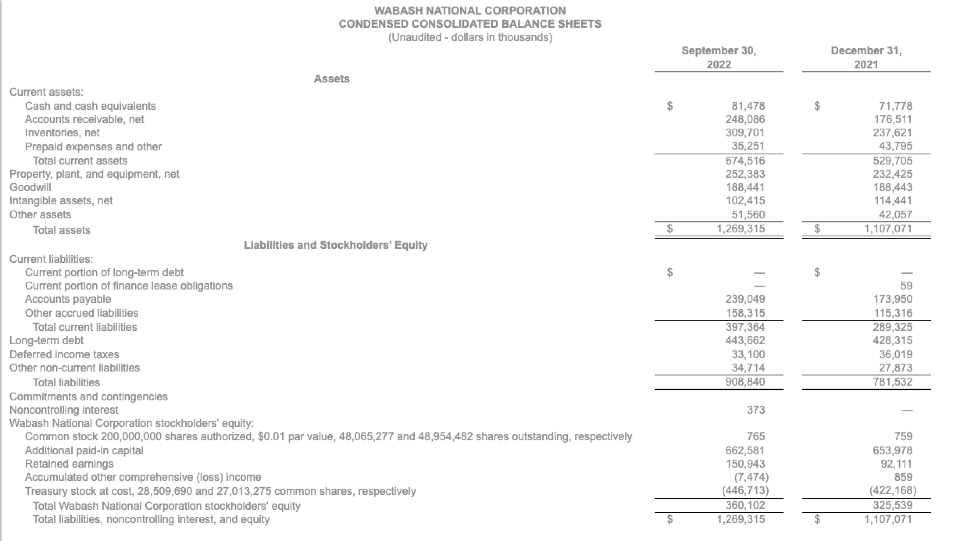
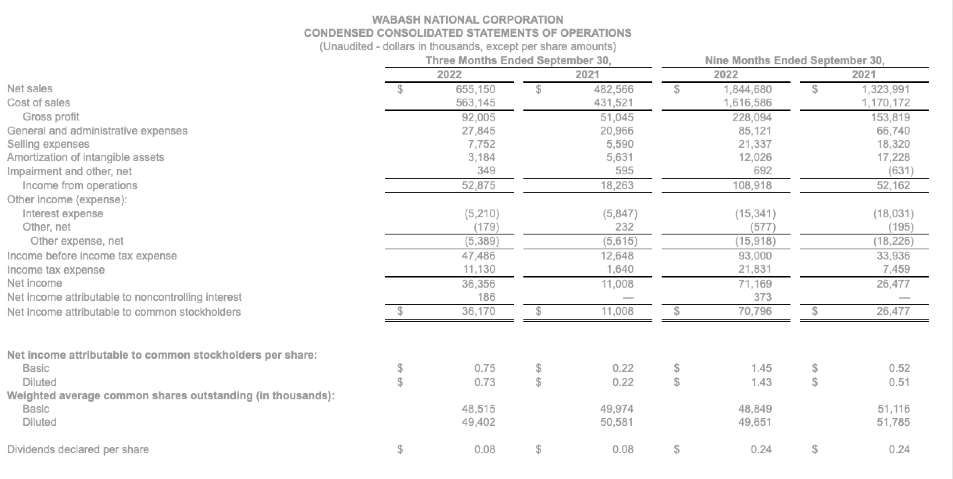
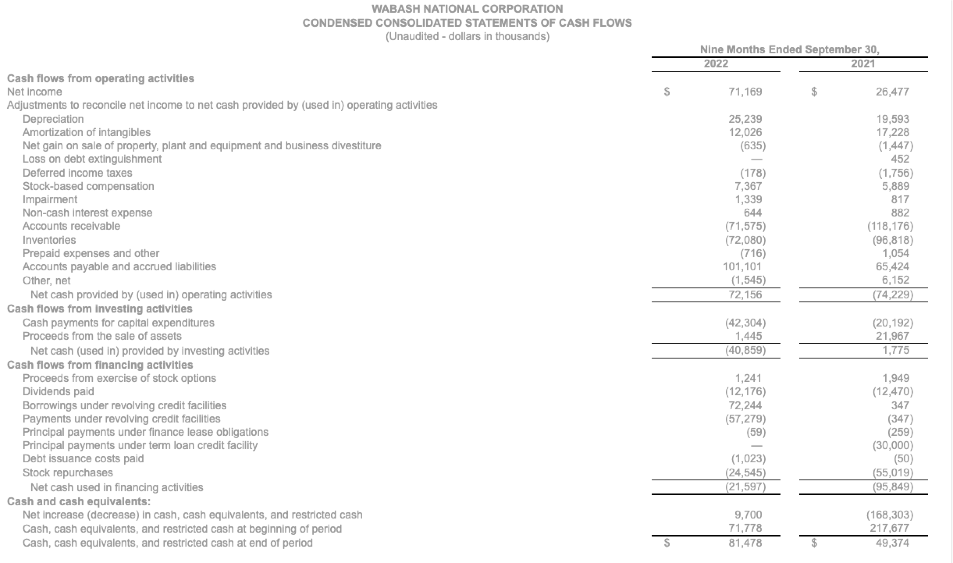
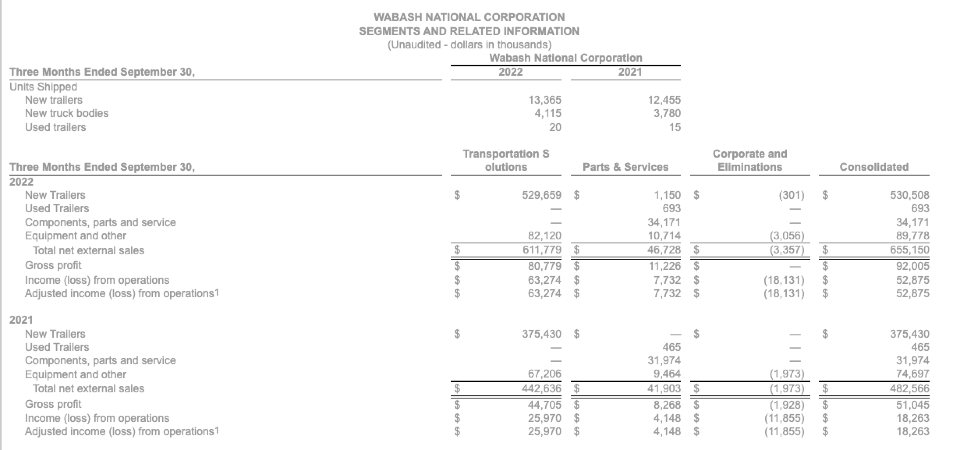
1 Adjusted operating income (loss), a non-GAAP financial measure, excludes certain costs, expenses, other charges, gains or income that are included in the determination of operating income (loss) under U.S. GAAP, but that management would not consider important in evaluating the quality of the Company’s operating results as they are not indicative of the Company’s core operating results or may obscure trends useful in evaluating the Company’s continuing activities. Accordingly, the Company presents adjusted operating income (loss) excluding these special items to help investors evaluate our operating performance and trends in our business consistent with how management evaluates such performance and trends. Further, the Company presents adjusted operating income (loss) to provide investors with a better understanding of the Company’s view of our results as compared to prior periods.
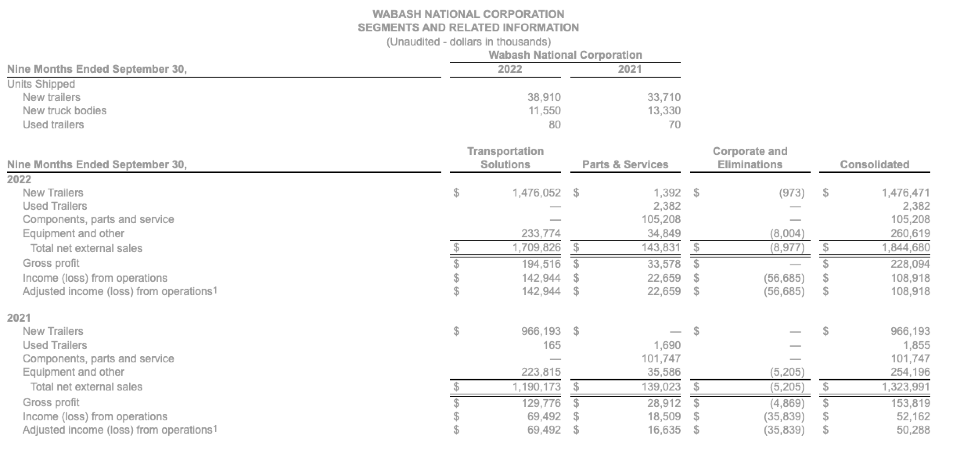
1 Adjusted operating income (loss), a non-GAAP financial measure, excludes certain costs, expenses, other charges, gains or income that are included in the determination of operating income (loss) under U.S. GAAP, but that management would not consider important in evaluating the quality of the Company’s operating results as they are not indicative of the Company’s core operating results or may obscure trends useful in evaluating the Company’s continuing activities. Accordingly, the Company presents adjusted operating income (loss) excluding these special items to help investors evaluate our operating performance and trends in our business consistent with how management evaluates such performance and trends. Further, the Company presents adjusted operating income (loss) to provide investors with a better understanding of the Company’s view of our results as compared to prior periods.
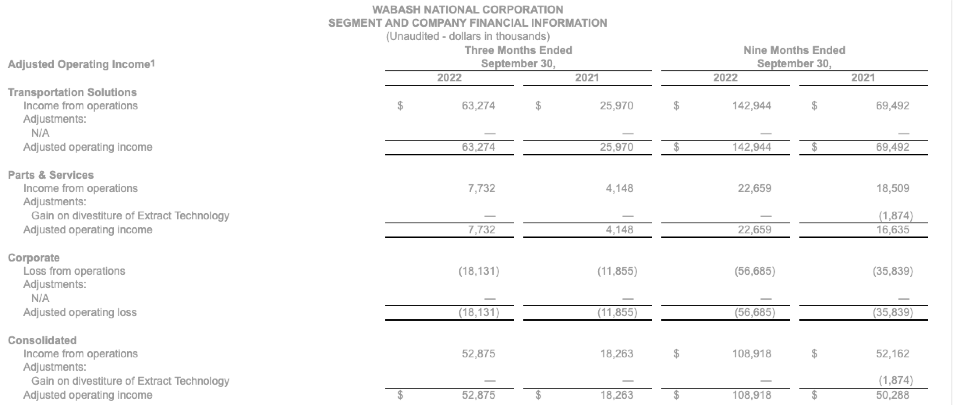
1 Adjusted operating income (loss), a non-GAAP financial measure, excludes certain costs, expenses, other charges, gains or income that are included in the determination of operating income (loss) under U.S. GAAP, but that management would not consider important in evaluating the quality of the Company’s operating results as they are not indicative of the Company’s core operating results or may obscure trends useful in evaluating the Company’s continuing activities. Accordingly, the Company presents adjusted operating income (loss) excluding these special items to help investors evaluate our operating performance and trends in our business consistent with how management evaluates such performance and trends. Further, the Company presents adjusted operating income (loss) to provide investors with a better understanding of the Company’s view of our results as compared to prior periods.
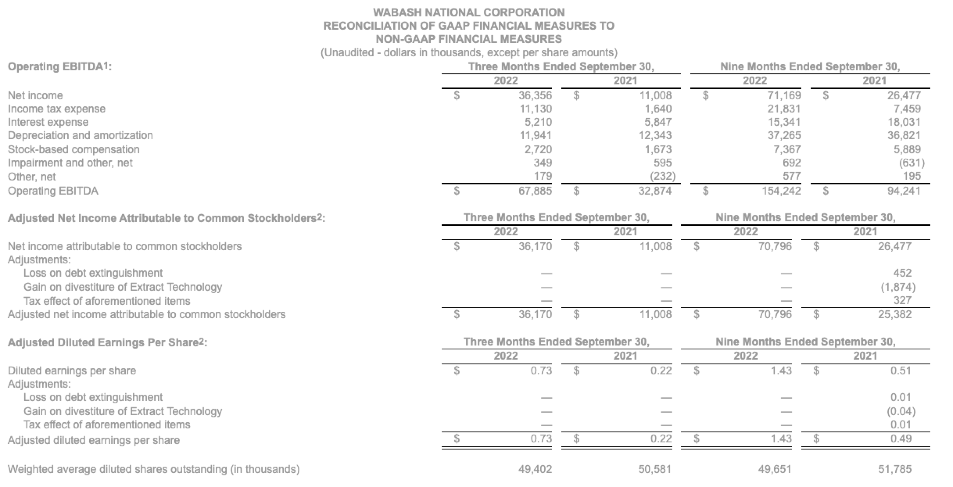
1 Operating EBITDA includes noncontrolling interest and is defined as earnings before interest, taxes, depreciation, amortization, stock-based compensation, impairment and other, net, and other non-operating income and expense (including any loss on debt extinguishment charges). Management believes providing operating EBITDA is useful for investors to understand the Company’s performance and results of operations period to period with the exclusion of the items identified above. Management believes the presentation of operating EBITDA, when combined with the GAAP presentations of operating income and net income, is beneficial to an investor’s understanding of the Company’s operating performance.
2 Adjusted net income attributable to common stockholders and adjusted diluted earnings per share reflect adjustments for debt transactions and the impact of sales and divestitures and the related tax effects of these adjustments.
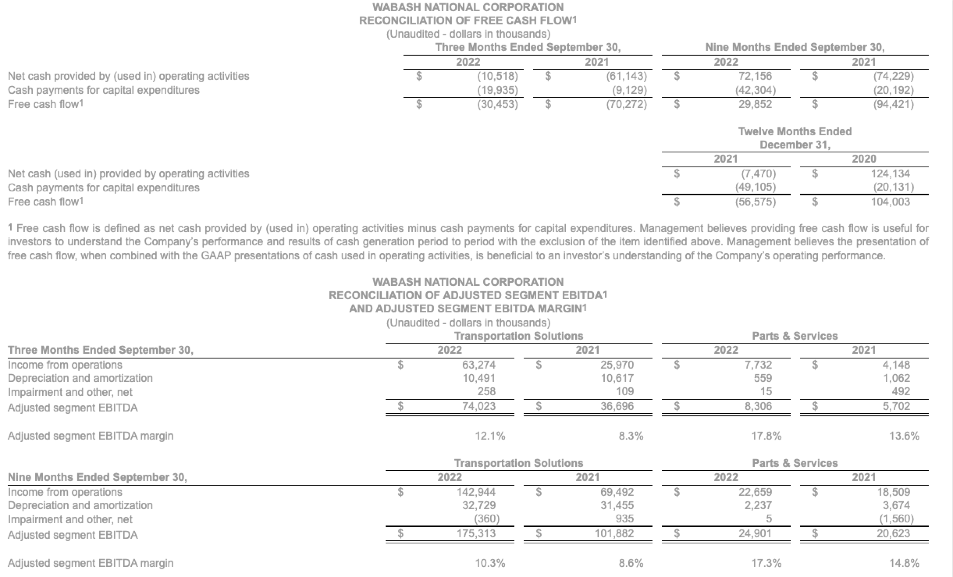
1 Adjusted segment EBITDA, a non-GAAP financial measure, includes noncontrolling interest and is calculated by adding back segment depreciation and amortization expense to segment operating income, and excludes certain costs, expenses, other charges, gains or income that are included in the determination of operating income under GAAP, but that management would not consider important in evaluating the quality of the Company’s segment operating results as they are not indicative of each segment's core operating results or may obscure trends useful in evaluating the segment's continuing activities. Adjusted segment EBITDA margin is calculated by dividing Adjusted segment EBITDA by segment total net sales.









